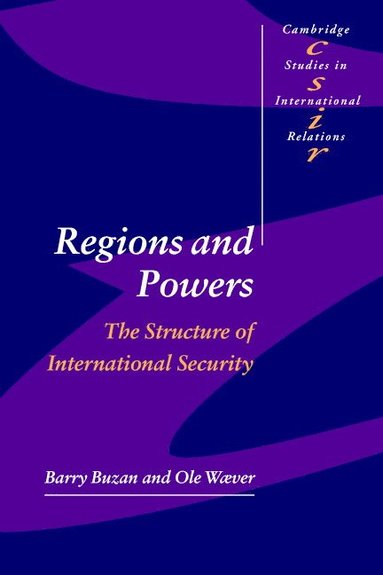
- Format
- Häftad (Paperback)
- Språk
- Engelska
- Antal sidor
- 598
- Utgivningsdatum
- 2003-12-01
- Förlag
- Cambridge University Press
- Medarbetare
- W'ver, Ole
- Illustratör/Fotograf
- 12 maps 1 fig
- Illustrationer
- fig.12M.
- Volymtitel
- Series Number 91 Regions and Powers: The Structure of International Security
- Dimensioner
- 230 x 155 x 37 mm
- Vikt
- Antal komponenter
- 1
- Komponenter
- 2:B&W 6 x 9 in or 229 x 152 mm Perfect Bound on Creme w/Gloss Lam
- ISBN
- 9780521891110
- 940 g
Regions and Powers
The Structure of International Security
- Skickas från oss inom 7-10 vardagar.
- Fri frakt över 249 kr för privatkunder i Sverige.
Passar bra ihop
De som köpt den här boken har ofta också köpt Who's Afraid of Gender? av Judith Butler (inbunden).
Köp båda 2 för 927 krKundrecensioner
Fler böcker av Barry Buzan
-
People, States and Fear
Barry Buzan
-
The Global Transformation
Barry Buzan
-
Security
Barry Buzan
-
International Systems in World History
Barry Buzan
Recensioner i media
'The empirical sweep of the study is monumental. This book is a major re-think of the problem of security in the post-Cold War world and successfully challenges conventional and competing approaches.' Kalevi J. Holsti, University of British Columbia
'The book is heroic in its ambition and Herculean in its execution. A landmark study that displays a rare combination of cutting-edge theoretical sophistication with an insatiable appetite for data.' Peter J. Katzenstein, Cornell University
'... offers a truly global empirical overview of security dynamics in all regions of the world.' Tidsskriftet Politik
'Among its most notable aspects are the clear prose and the sharp focus of the empirical studies ... The empirical study is nothing short of titanic in its ambition and breadth, and the succinct overviews of regional security dynamics will undoubtedly become required reading in graduate security studies curricula.' Slavonic and East European Review
'This is undoubtedly an important volume that makes a significant contribution to security studies' Political Studies Review
'... A sophisticated analytical toolbox equipped with a plethora of useful concepts and categories, heuristic models and methods, checklists of comparative criteria, etc. ... this is a valuable study and it should be read by both security/IR scholars and policy practicioners. As a macro-study with a global sweep, the book opens the door up to research programming to students of security, above all in terms of the more detailed micro-studies of and within various RSCs.' Journal of International Relations and Development
Övrig information
Barry Buzan is Professor of International Relations at the LSE. Ole W'ver is Professor of International Relations at the Department of Political Science, University of Copenhagen.
Innehållsförteckning
Part I. Introduction: Developing a Regional Approach to Global Security: 1. Theories and histories about the structure of contemporary international security; 2. Levels: distinguishing the regional from the global; 3. Security complexes: a theory of regional security; Part II. Asia: 4. South Asia: inching towards internal and external transformation; 5. Northeast and southeast Asian security complexes during the Cold War; 6. The 1990s and beyond: an emergent east Asian complex; Conclusion; Part III. The Middle East and Africa: Introduction; 7. The Middle East: a perennial conflict formation; 8. Sub-saharan Africa: security dynamics in a setting of weak and failed states; Conclusions; Part IV. The Americas: 9. North America: the sole superpower and its surroundings; 10. South America: an under-conflictual anomaly?; Conclusion: scenarios for the RSCs of the Americas; Part V. The Europes: Introduction: 11. EU-Europe: the European Union and its 'near abroad'; 12. The Balkans and Turkey; 13. The post-Soviet space: a regional security complex around Russia; Conclusion: scenarios for the European supercomplex; Part VI. Conclusions: 14. Regions and powers: summing up and looking ahead; 15. Reflections on conceptualising international security.
Du kanske gillar
-
The Avoidable War
Kevin Rudd
InbundenKnife
Salman Rushdie
InbundenFrågor & svar


